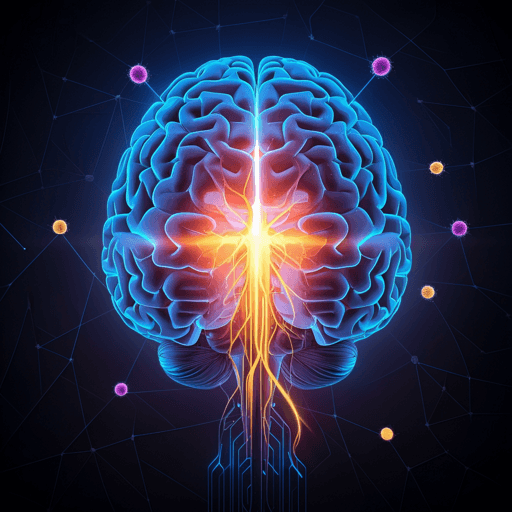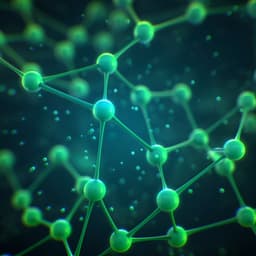
Interdisciplinary Studies
A simple model for Behavioral Time Scale Synaptic Plasticity (BTSP) provides content addressable memory with binary synapses and one-shot learning
Y. Wu and W. Maass
Discover how Behavioral Time scale Synaptic Plasticity enables one-shot memory formation in hippocampal CA1, creating powerful content-addressable memories without high-resolution synapses. The transparent model reproduces human memory repulsion and points to energy-efficient on-chip learning with memristor crossbars. Research conducted by Yujie Wu and Wolfgang Maass.
~3 min • Beginner • English
Introduction
The study addresses how the brain creates episodic memory traces on the fly that can be reactivated from partial cues—i.e., content-addressable memory (CAM) via one-shot learning. Recent experiments identified Behavioral Time Scale Synaptic Plasticity (BTSP) in CA1 as a key mechanism, gated by stochastic entorhinal cortex inputs that induce plateau potentials lasting seconds. BTSP differs from Hebbian and STDP rules: it does not depend on postsynaptic firing, operates effectively in single trials, and the direction of synaptic change depends on prior weight and timing relative to plateau potentials. Prior models used continuous-time, continuous-weight deterministic formulations, despite experimental trial-to-trial variability. The research question is whether a simple stochastic BTSP rule with binary synapses can capture core experimental features and yield a high-capacity, robust CAM for sparse, overlapping memory items, with one-shot learning and attractive neuromorphic hardware properties.
Literature Review
- BTSP has been experimentally demonstrated in awake animals and linked to CA1 place field formation and episodic memory encoding (Bittner 2017; Grienberger & Magee 2022). Prior mathematical models used continuous weights and deterministic dynamics without noise (e.g., Milstein et al. 2021). Experimental data indicate substantial trial-to-trial variability of BTSP-induced weight changes.
- Classical content-addressable memory models, notably Hopfield networks (HFNs), require synaptic weights with many distinguishable values; capacity drops drastically with binary quantization. Online learning rules for HFNs with binary weights are lacking.
- The fly algorithm and random projection (RP) approaches use fixed random binary projections; they do not learn weights tailored to stored items and require architectural constraints (large expansion, global winner-take-all) unsuitable for hippocampal scale.
- Neuromorphic implementations of CAMs have used memristor crossbar arrays for HFNs but rely on off-chip learning and multi-level weights, limiting capacity.
- Other one-shot memory mechanisms (e.g., Imam & Cleland’s olfactory circuit) rely on multi-valued synapses or adding neurons, differing from BTSP’s binary synapse viability and fixed architecture.
- Sparse coding regimes (~0.5% active neurons) are typical in hippocampus and V1, motivating sparse CAM evaluation.
Methodology
- Proposed simplified stochastic BTSP rule with binary synaptic weights (0/1). When an input pattern arrives within a 10 s plasticity window around the onset of a plateau potential in a CA1 neuron, synapses from active inputs are potentiated if currently 0 or depressed if currently 1, each with probability 0.5; otherwise weights remain unchanged. A "core BTSP" variant folds the 0.5 factor into plateau probability and yields similar outcomes.
- Network model: feedforward two-layer architecture mapping m input neurons (CA3-like) to n memory neurons (CA1-like). Memory neurons are disconnected McCulloch-Pitts units with thresholds chosen via grid search to optimize recall from partial cues.
- Biological parameterization: default m=25,000; n=39,000; sparse input density f_p=0.005; connection probability f_w=0.6; plateau potential probability per item per neuron f_q≈0.005, derived from measured plateau rate (~0.0005/s) times 10 s plasticity window duration.
- Learning: one-shot presentation of M patterns; for each item, a random subset of memory neurons receives plateau potentials (independently with probability f_q). Weights update according to the BTSP rule.
- Recall evaluation: present original or masked cues x' (a fraction of 1’s turned to 0’s; also evaluated two-sided noise where 0’s may flip to 1’s). Measure memory trace z(x) as the set of memory neurons firing to x. Use Hamming distance (HD) and relative dissimilarity HD(z(x),z(x')) / HD(z(x_a),z(x_b)).
- Theoretical analysis: derive firing probabilities and HD estimates using binomial distributions and parity (odd/even) of weight updates. Lemma provides probabilities for even/odd numbers of Bernoulli trials. Closed-form expressions estimate: probability a synapse remains active after learning (depends on whether the neuron received plateau for the item), memory neuron firing probabilities given thresholds, expected HD for masked vs different items, and overlapping items (with c common 1’s). Theory validated against simulations.
- Comparisons: implement Random Projection (RP) with binary weights matched to BTSP weight density; optimize RP thresholds. Implement classical HFN with continuous weights (Hebbian learning; synchronous updates for 100 iterations during retrieval); evaluate quantization to binary. All models use same input sparsity and connectivity where applicable.
- Input reconstruction (CAM test): add random feedback connections from memory neurons to input layer, trained with a one-shot Hebbian-like rule (increment to saturation on co-activity). During recall, present masked cue x' for one step, then overwrite input with internally generated pattern r(x') via feedback; evaluate scaled reconstruction error HD(x,r(x')) / HD(x,x'). Include a visual line-drawing task with 50x50 sparse patterns, including pairs with high overlap.
- Parameter sweeps: analyze impact of f_q and LTD probability on trace size, overlap, recall robustness, and repulsion effect; thresholds set via grid search or linear fits based on average input activity.
Key Findings
- A simple stochastic BTSP rule with binary synapses reproduces core experimental BTSP features, including instantaneous creation of new place fields and speed-dependent expansion reflecting a seconds-long plasticity window.
- BTSP with binary weights forms high-capacity CAMs under sparse coding, enabling one-shot learning and robust recall from partial cues: relative dissimilarity remains low up to ~33% masking of input 1’s; two-sided noise (0↔1 flips) is similarly tolerated.
- The plateau potential probability f_q critically shapes memory system properties. Experimentally suggested f_q≈0.005 yields a sweet spot: memory traces of manageable size, limited overlap, and strong recall robustness. Larger f_q (e.g., 0.01) increases trace overlap and reduces recall with masked cues; lower f_q can further improve input completion but weakens repulsion.
- BTSP creates bimodal distributions of synaptic input sums in memory neurons (depending on whether a plateau occurred for an item), allowing thresholds between clusters and enhancing noise robustness. RP produces unimodal sums near threshold and fails under masking.
- Compared to RP, BTSP enables robust recall and downstream classification robustness; RP tolerates little masking.
- BTSP CAM performance with binary weights is comparable to or sometimes superior to classical HFNs with continuous weights for sparse inputs and incomplete connectivity, while HFN weights quantized to binary show drastic capacity drops.
- Overlapping memory items: BTSP stores and separates items sharing up to ~30% common 1’s, with good recall under 33% masking. Theory (Eqs. S7/S8) matches simulations.
- Input reconstruction: With simple feedback trained in one shot, BTSP reconstructs masked inputs effectively; scaled reconstruction error HD(x,r(x')) / HD(x,x') remains substantially below 1 across large M and high masking. Performance comparable to HFNs with continuous weights; BTSP provides immediate reconstruction without iterative convergence.
- Repulsion effect: BTSP reproduces the human-memory-like repulsion, reducing overlap of memory traces for highly similar items (e.g., 40% overlap), unlike RP which increases overlap. LTD component is essential; increasing LTD probability strengthens repulsion. Repulsion emerges for f_q above ~0.005; below this, repulsion is weak or absent.
- Scaling: Theory predicts excellent recall for human-scale sparse networks (100× inputs, 1/100 input density) up to ~800,000 items even with up to 2/3 masking, though simulations at this scale were not run.
- Neuromorphic implications: BTSP-based CAMs require only binary synapses, enabling on-chip one-shot learning in memristor crossbar arrays, potentially matching or exceeding CAM quality of continuous-weight HFNs while being more energy-efficient.
Discussion
The findings show that BTSP’s stochastic gating by entorhinal plateau potentials, independent of postsynaptic firing, can underpin a powerful CAM with binary synapses and one-shot learning. This mechanism addresses the challenge of allocating neurons to episodic memory traces on the fly and supports robust recall from partial cues due to bimodal input distributions and attractor-like properties. The critical parameter f_q, set by the rate and window of plateau potentials, tunes trace size, overlap, recall robustness, and repulsion; the experimentally observed value (~0.005) is near-optimal. BTSP separates similar memories via LTD-induced repulsion during learning, enabling differential downstream processing consistent with human hippocampal data. Compared to RP and HFNs, BTSP offers a learned, item-tailored projection creating attractors without requiring multi-level synaptic precision or iterative retrieval, aligning with sparse biological coding and offering advantages for neuromorphic CAMs. The analytical framework bridges CA1 synaptic plasticity with memory system function and provides predictive tools for capacity and robustness across parameter regimes.
Conclusion
This work introduces a simple, analytically tractable BTSP model with binary synapses that enables one-shot creation of content-addressable memory for sparse, overlapping items. It reproduces experimental BTSP signatures, achieves robust recall and input reconstruction with partial cues, and uniquely captures the hippocampal repulsion effect for similar memories via LTD. BTSP’s stochastic gating spreads memory load and preserves earlier traces, while its binary synapses suit energy-efficient neuromorphic implementations in memristor arrays. Theoretical analysis predicts high capacity at brain-like scales, suggesting BTSP-based CAMs as practical alternatives to HFNs requiring many weight levels. Future directions include: elucidating biological mechanisms of feedback for reconstruction; refining synapse models (e.g., number of release sites, multi-synapse structure); exploring spiking implementations; optimizing f_q and LTD probabilities for application-specific trade-offs; scaling simulations to human-size networks; and integrating BTSP learning into hardware designs for large-capacity CAM.
Limitations
- The model assumes statistical independence between presynaptic input timing and plateau potential onset, using a 0.5 probability for LTP vs LTD within the plasticity window.
- Synaptic strengths are simplified to binary values; the actual number of release sites and possible multi-level weights in CA1 synapses are unknown.
- Memory neurons are modeled as disconnected McCulloch-Pitts units; lateral connectivity and biophysical details are abstracted.
- Firing thresholds are selected via grid search or fitted linear functions; reliable biological measurements for CA1 thresholds are lacking.
- Some theoretical estimates approximate dependencies (e.g., factorization in HD estimates) and use binomial parity assumptions; more precise derivations are in the supplement.
- Human-scale capacity results are theoretical; simulations at those scales were not performed due to computational limits.
- Feedback connections for input reconstruction are random and trained with a simple Hebbian-like rule; biological implementation and plasticity are opaque.
- Performance and repulsion depend on parameter f_q and LTD probability; mapping these precisely to diverse biological conditions remains to be validated.
Related Publications
Explore these studies to deepen your understanding of the subject.







